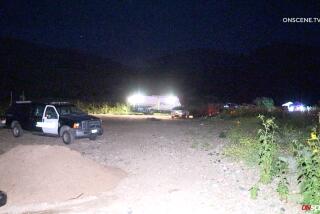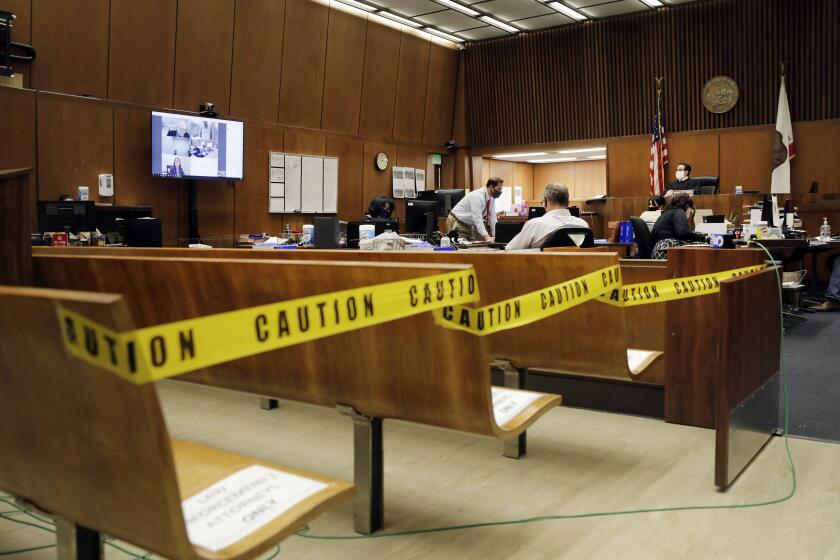Pilot Told of Bad Weather, FAA Says of Crash Killing 10
Aviation sources say the pilot of a charter plane ignored weather warnings and apparently was following a dangerous flight procedure called “scud-running” when his twin-engine aircraft slammed into a cloud-shrouded mountain ridge above Corona on Sunday, killing all 10 aboard.
The Federal Aviation Administration said Tuesday that pilot Hassan Berro, 34, received an FAA warning before taking off from Las Vegas that because of low clouds and drizzle, flying to Orange County’s John Wayne Airport under visual flight rules (VFR), rather than instrument flight rules (IFR), “would not be recommended.”
Nonetheless, officials said, Berro elected to file a VFR flight plan.
That meant that instead of relying on the plane’s instruments and directions from air traffic controllers to guide the flight, Berro elected to rely on his own eyes and visual references to fly the plane. It also meant that the charter firm did not have to send along a co-pilot.
Veteran pilots said that as Berro headed into the Santa Ana Mountains southwest of Riverside, he apparently tried to fly through the narrowing gap between the rising mountains and the descending overcast.
“It’s called scud-running,” said airline pilot and aviation safety expert Barry Schiff. “It’s when you attempt to fly between the terrain and very low clouds.
“It’s a very dangerous procedure. Sometimes you get away with it. Sometimes you stick your head too far into the lion’s mouth. I’m not saying that’s what he did, but there’s a very strong possibility that’s what he did.”
Schiff noted that scud running is apparently what killed renowned stunt pilot Frank Tallman when his Piper Aztec crashed in the same mountains in 1978 while Tallman was headed for the same airport.
The Cessna 402 piloted by Berro crashed at about midday Sunday after failing to clear the 2,274-foot crest of a ridge by a scant 100 feet. The crash claimed the lives of the pilot and a family of nine that included five children, their parents and two other relatives. The passengers, all from the Las Vegas area, had been heading for an outing at Disneyland.
Robert Thompson, one of Berro’s partners in Las Vegas Flyers charter service, and Jim Van Cleve, a veteran pilot with a rival firm, both described Berro as a skilled pilot. Thompson, who taught Berro to fly, said Berro was fully qualified to pilot both single- and twin-engine aircraft, had been instrument-rated and held an air transport pilot’s certificate.
Before taking off on Sunday, Berro filled the plane’s wing-tip tanks with more than enough fuel to complete the flight, according to Alan Pollock, a spokesman for the National Transportation Safety Board, which is heading the official investigation into the crash.
FAA spokeswoman Barbara Abels said Berro also telephoned the automated flight service station in Reno to receive an up-to-date rundown on the weather conditions between Las Vegas and Orange County. It was this report, Abels said, that warned against a VFR flight.
Marty Kay, a spokesman for Las Vegas Flyers, acknowledged that flight conditions were “what we call marginal VFR, from time to time,” but he said marginal VFR, “to a professional pilot, is nothing more than normal flying.”
Thompson stressed that “it’s perfectly legal to fly under those circumstances.” However, Bill Munnerlyn, owner of Skyway Jet Charter in Las Vegas, said he took the warning more seriously.
Turned Down Flight
Munnerlyn said that when the same family approached him on Saturday about making the flight the following day, he turned them down. He explained that because of the weather forecast, he was unwilling to make the trip under visual flight rules. He said that his plane carries only nine persons, and that to make the flight under instrument rules, he would have had to follow FAA regulations requiring a co-pilot for IFR charter flights.
Berro apparently took off without incident and flew southwest across the eastern Mojave Desert and the San Bernardino Mountains. As he passed near Ontario International Airport, he contacted the FAA’s Terminal Radar Approach Control facility at the airport.
The FAA declined comment Tuesday on the conversations between the controllers and Berro, although these conversations--and the data that appeared on the controllers’ screens--have been recorded.
Aviation sources said Berro may have contacted the controllers because he was entering the restricted airspace around the airport. These sources said the controllers probably advised Berro of traffic along his flight path. It was not revealed whether the controllers ever advised the pilot that he might be flying dangerously low.
Used as Alternative
“Scud-running”--so named because clouds are known in aeronautical jargon as “scuds”--is used by some pilots as an alternative to having to switch to more cumbersome instrument flight rules when traversing marginally overcast skies, according to Dave Templeton, a flight instructor at Martin Aviation, a plane-servicing company at John Wayne Airport.
“I hate to say it’s common, but if you have a little layer of clouds and you want to get around the clouds, some pilots just scud-run around them,” Templeton said. “It’s something that’s not taught and not recommended.”
Typically, the pilots who scud-run are either not instrument-rated or originate from other areas and are not familiar with changing weather patterns in the Los Angeles Basin, Jim Miller, an FFA official in El Toro, said.
Miller, who is assistant manager for plans and procedures at the FAA’s Coast Terminal Radar and Approach Control (TRACON) facility in El Toro, said private pilots routinely practice “scud-running” over Orange County.
But while legal, aviation experts say, the practice is hazardous.
Cause of Many Accidents
“I would say there are many accidents caused by this,” said Miller, whose air traffic control facility guides aircraft over a large portion of the county.
“Scud-running is one of general aviation’s most tempting and hazardous procedures,” Schiff wrote in a 1981 article on the subject for an aviation trade magazine. “It claims numerous lives every year.”
“Scud-running” becomes especially dangerous in mountainous areas such as eastern Orange County, where the terrain rises at a steep rate, Miller said.
“The problem is for the pilot trying to stay below the clouds and above the terrain,” Miller said. “If you’re flying in Kansas, it’s no problem. But in California with the high terrain, it becomes a problem.”
Staff Writer Jim Carlton contributed to this report from Orange County. Malnic reported from Los Angeles and Sahagun from Las Vegas.
More to Read
Start your day right
Sign up for Essential California for news, features and recommendations from the L.A. Times and beyond in your inbox six days a week.
You may occasionally receive promotional content from the Los Angeles Times.






